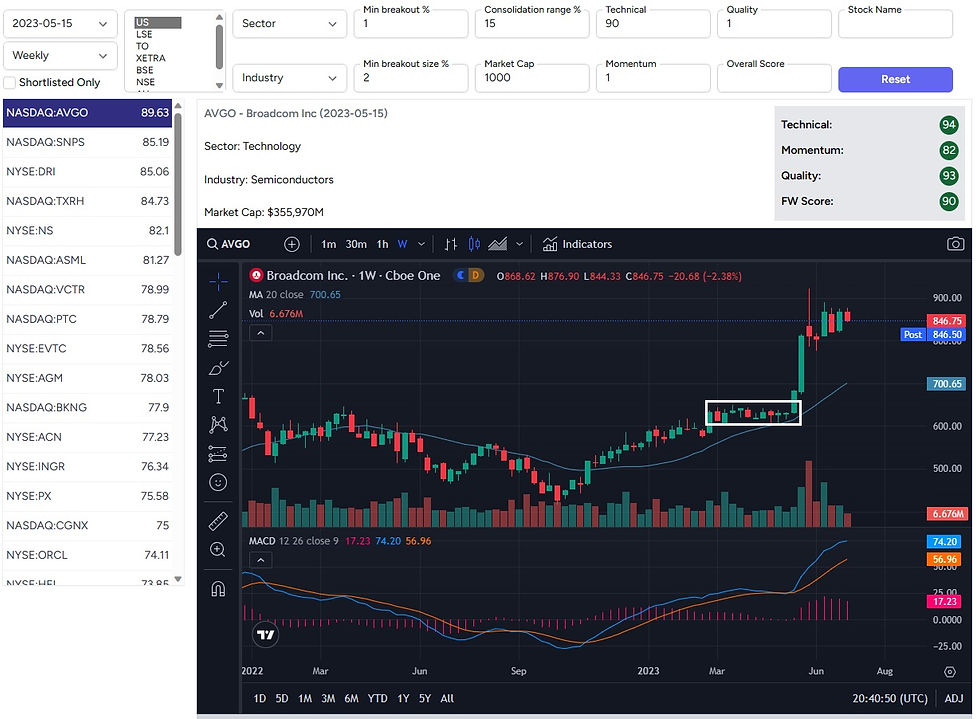Jim Slater’s PEG Method (Zulu Principle) Explained
- FinancialWisdom

- Sep 16
- 7 min read
You’ve heard of P/E, but PEG is where growth meets value.
What if I told you that one of Britain's most successful investors developed a strategy so powerful it returned over 1,300% since inception between 2011 and 2025, yet his name has been virtually forgotten by anyone under 50?
The BBC said it best in his obituary: "The name probably means nothing to anyone under the age of 50, but in the 1970s Jim Slater was a truly famous businessman."
Today, we're going to dissect Jim Slater's legendary Zulu Principle—a systematic approach that crushed the market for decades. And here's what makes this particularly fascinating: Stockopedia’s recent backtesting shows his methods still work today, even after Covid, inflation, and rising interest rates.
Before we begin: this video is for educational purposes only. It is not financial advice and should not be relied upon for investment decisions. Always do your own research, and if in doubt, consult a qualified professional.
Jim Slater wasn't just another investor—he was a pioneer who developed systematic approaches to stock selection decades before computers made such analysis commonplace. His "Capitalist" portfolio in the 1960s returned 68.9% against a market average of just 3.6%. He later refined his approach and developed the Zulu Principle in the 1990s, which continued delivering exceptional returns.
What makes Slater's approach so compelling is that it's based on timeless principles that modern finance research has validated: quality companies, reasonable valuations, and momentum. These same factors form the backbone of today's most sophisticated investment platforms.
We'll examine both his original 1960s strategy and his evolved Zulu Principle, see how they perform in modern markets, and extract the key lessons every serious investor should understand.

Let's start at the beginning. In 1959, Jim Slater began investing without the luxury of computers or real-time data. So he did something ingenious—he created his own backtesting system using old magazines.
Slater bought two years' worth of back issues of The Investors Chronicle and the Stock Exchange Gazette. With the benefit of hindsight, he analyzed which share recommendations actually delivered results and which turned out to be duds. This painstaking process helped him identify the traits present before periods of strong price performance.
From this analysis, Slater developed what he called his "earning situations" strategy, focusing on turnaround companies. His theory was brilliant in its simplicity: turnaround companies often stayed undervalued because the market remained skeptical after years of poor performance.
As Slater explained: "Quite often after a period of losses it would take a long time for the stock market to forgive and forget, so the rating given to these companies was not high enough in relation to their recent earnings trend."
This led to his famous nine "Capitalist" rules, published in 1963 when he wrote an investment column in The Sunday Telegraph:
1. The dividend yield must be at least 4 percent
2. Equity earnings must have increased in at least four out of the last five years
3. Equity earnings must have at least doubled over the last four years
4. The latest Chairman's statement must be optimistic
5. The company must be in a reasonable liquid position
6. The company must not be vulnerable to exceptional factors
7. The shares must have a reasonable asset value
8. The company should not be family-controlled
9. The shares should have votes
Notice the systematic approach here. Rule 1 ensured the company was undervalued and generating enough cash to pay dividends. Rules 2 and 3 focused on strong earnings growth, while Rules 5 and 7 ensured healthy balance sheets. This was essentially a prototype GARP strategy—Growth at a Reasonable Price—decades before the term was coined.
The results speak for themselves. Slater's "Capitalist" portfolio appreciated by 68.9% over two years against a market average of only 3.6%. That's not luck—that's systematic excellence.

Today, you don’t need to dig through old newspapers. Platforms like Stockopedia make these strategies accessible in seconds through what are called Guru Screens — ready-made templates based on famous investors’ rules.”
But here's the critical question: would those 1960s rules still work in today's markets?
Recent analysis by Stockopedia adapted Slater's criteria for modern conditions and ran a simulation from 2015 to 2025. The results were fascinating. Despite facing Covid, inflation, geopolitical crises, and rising interest rates, the strategy still identified strong performers.
Some standout examples include:
Stock Spirits, which gained 42% between June and September 2021.
Morses Club delivered a remarkable 76% gain between March and June 2021.
Steppe Cement gained 44% in the same period, with the Malaysia-based company reporting 14% profit growth and 20% export volume increases.
What's particularly interesting is that the number of qualifying companies dropped significantly after Covid, likely due to slower earnings growth and tighter balance sheet requirements in higher interest rate environments. Yet the strategy continued to outperform, proving that Slater's principles remain sound even when opportunities become scarcer.
By 1992, Slater had evolved his approach significantly. His book "The Zulu Principle" introduced refined criteria that reflected decades of market experience and changing conditions.
The new approach centered on six key filters:
1. PEG ratio below 0.75—indicating growth at a reasonable price
2. Price-to-Earnings ratio under 20—avoiding overvalued stocks
3. Earnings per Share growth over 15%—selecting companies with strong recent growth
4. 1-year relative strength greater than 0%—focusing on stocks outperforming the market
5. Return on Capital Employed above 12%—ensuring efficient, profitable use of capital
6. Market capitalization between £20 million and £1 billion—targeting small to mid-cap growth opportunities
This evolution reflected several crucial insights. First, Slater introduced the PEG ratio—a composite measure that divides a company's P/E ratio by its earnings growth rate. A lower PEG suggests growth at a reasonable price, combining value and growth principles in a single metric.

Second, he deliberately focused on smaller companies, famously stating: "Elephants don't gallop." Larger companies simply have less scope for rapid earnings expansion due to their size and market maturity.
Most importantly, Slater incorporated momentum into his strategy through the relative strength requirement. This was a significant philosophical shift for someone who initially dismissed technical analysis, once writing: "About twenty years ago, I observed that chartists usually had dirty raincoats and large overdrafts... Even now I do not know many rich chartists."
But Slater's views evolved as he recognized the wisdom of crowds: "I give technical analysis much more credence than before... Other investors may be selling after becoming aware of problems that you have not yet identified... If the shares are not keeping up with the market, you should be on red alert."
This willingness to overcome cognitive biases and adapt his approach demonstrates the intellectual honesty that separates great investors from the merely good.
Stockopedia also backtested the Zulu approach between 2011 and 2025. The portfolio followed a deceptively simple but powerful construction method. Every three months, the screen is completely rebalanced. At each rebalance date, the system buys all stocks that meet the Slater criteria and sells any holdings that no longer qualify. If additional stocks meet the criteria between rebalance dates, they are not added to the portfolio. Holdings are only updated quarterly.
The strategy delivered exceptional results, returning over 1,300% since inception. It consistently outperformed the FTSE All Share, beating the market every year except 2014, 2016, and 2024.
Some remarkable performers included:
Gaming Realms, which topped the performance table with a 43.3% gain in just three months during 2025, annualizing to an extraordinary 450.8%.
Games Workshop appeared in the screen from October to December 2017, gaining 33.7% in just three months. This company exemplifies the power of Slater's approach—it didn't just deliver short-term gains but went on to increase earnings fourteen-fold over a decade, with dividends alone in 2024 totaling 420p per share for investors who bought at 500p ten years earlier.
Xaar, the digital inkjet technology company, appeared twice in the screen during 2013, delivering gains of 16% and 40% respectively.
What's fascinating is how the strategy captured what’s called the Post-Earnings Announcement Drift—the tendency for stocks to continue rising after beating earnings expectations. Since Slater's screen targets companies with high earnings growth, many top performers had earnings "ahead of expectations” - a winning stock characteristic we have covered in detail in this video.
The strategy also aligns perfectly with the three factors that drive long-term returns: Quality (profitable, financially sound companies), Value (reasonable valuations), and Momentum (stocks with strong price momentum).
The genius of Slater's approach lies not just in the metrics, but in the psychological framework it creates. By focusing on systematic rules rather than gut feelings or market predictions, investors avoid the emotional pitfalls that destroy most portfolios.
Consider the psychological benefits:
The strategy removes emotion from decision-making. When you have clear, quantifiable criteria, you're less likely to be swayed by market noise or media headlines.
It forces discipline through regular rebalancing. Slater's approach required quarterly reviews, selling stocks that no longer qualified and buying new ones that met the criteria. This systematic approach prevents the common mistake of falling in love with losing positions.
The momentum component captures market psychology. By requiring positive relative strength, the strategy avoids stocks that other investors are abandoning, often for reasons individual investors haven't yet identified.
Most importantly, it's based on business fundamentals. Every criterion relates to actual business performance—earnings growth, profitability, balance sheet strength. This grounds the strategy in economic reality rather than market sentiment.
But what happens when no companies qualify for the strict Zulu criteria? This actually occurs regularly in today's markets, and it's not a problem—it's valuable information. It tells us the market isn't offering many opportunities that meet Slater's demanding standards.
When this happens, you have several options:
First, relax the criteria slightly. Instead of requiring PEG ratios under 0.75, you might expand to under 1.0. The key is maintaining the systematic approach while adapting to market conditions.
Second, broaden your search internationally. The same Zulu principles can be applied to European or global markets, often revealing more opportunities than the UK alone.
Third, combine screening with news analysis. Many of the best opportunities appear in trading updates, earnings beats, or corporate developments. Screening helps filter the universe, while news analysis helps evaluate whether the story is compelling.
On Stockopedia, you can run these screens instantly across thousands of companies, something that would have taken Slater weeks to accomplish manually.
Jim Slater's legacy extends far beyond his impressive returns. He proved that systematic, rules-based investing could consistently beat the market, but only if you're willing to evolve your approach as conditions change.
The core lessons remain timeless: focus on quality companies with strong earnings growth, buy them at reasonable prices, and pay attention to market momentum. Combine this with systematic discipline and regular rebalancing, and you have a framework that has worked for decades.
With tools like Stockopedia, you can explore his Zulu Principle strategy, compare it with other great Guru investors like Warren Buffett or Joel Greenblatt… or even build your own custom screen where you can tailor the rules to meet your own investing style.
The tools Slater must have wished he had are now much easier to access.” The tools exist. The principles are proven. The only question remaining is: will you use them?
For those interested in using my breakout method and bespoke scanner, why not join us: https://www.financialwisdomtv.com/service
My Service:


FREE E-Book Click Here - Professional Swing Trading Platform - Award Winning Swing Trader





Comments